Abenezer Girma
A Robust Completed Local Binary Pattern for Surface Defect Detection
Dec 07, 2021


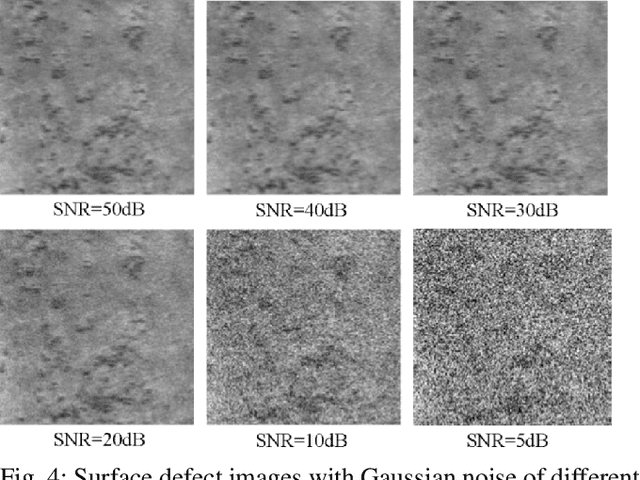
Abstract:In this paper, we present a Robust Completed Local Binary Pattern (RCLBP) framework for a surface defect detection task. Our approach uses a combination of Non-Local (NL) means filter with wavelet thresholding and Completed Local Binary Pattern (CLBP) to extract robust features which are fed into classifiers for surface defects detection. This paper combines three components: A denoising technique based on Non-Local (NL) means filter with wavelet thresholding is established to denoise the noisy image while preserving the textures and edges. Second, discriminative features are extracted using the CLBP technique. Finally, the discriminative features are fed into the classifiers to build the detection model and evaluate the performance of the proposed framework. The performance of the defect detection models are evaluated using a real-world steel surface defect database from Northeastern University (NEU). Experimental results demonstrate that the proposed approach RCLBP is noise robust and can be applied for surface defect detection under varying conditions of intra-class and inter-class changes and with illumination changes.
DA$^{\textbf{2}}$-Net : Diverse & Adaptive Attention Convolutional Neural Network
Nov 25, 2021


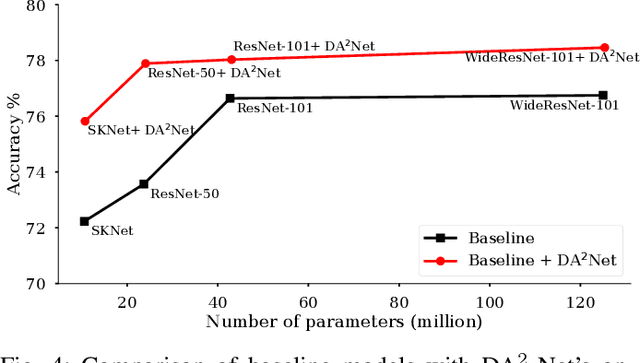
Abstract:Standard Convolutional Neural Network (CNN) designs rarely focus on the importance of explicitly capturing diverse features to enhance the network's performance. Instead, most existing methods follow an indirect approach of increasing or tuning the networks' depth and width, which in many cases significantly increases the computational cost. Inspired by a biological visual system, we propose a Diverse and Adaptive Attention Convolutional Network (DA$^{2}$-Net), which enables any feed-forward CNNs to explicitly capture diverse features and adaptively select and emphasize the most informative features to efficiently boost the network's performance. DA$^{2}$-Net incurs negligible computational overhead and it is designed to be easily integrated with any CNN architecture. We extensively evaluated DA$^{2}$-Net on benchmark datasets, including CIFAR100, SVHN, and ImageNet, with various CNN architectures. The experimental results show DA$^{2}$-Net provides a significant performance improvement with very minimal computational overhead.
A Framework for eVTOL Performance Evaluation in Urban Air Mobility Realm
Nov 09, 2021
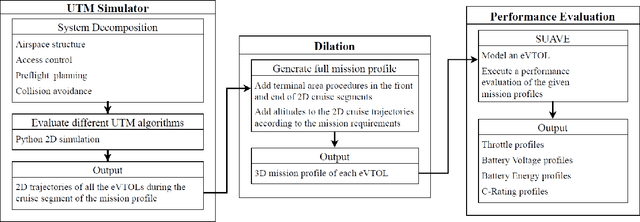
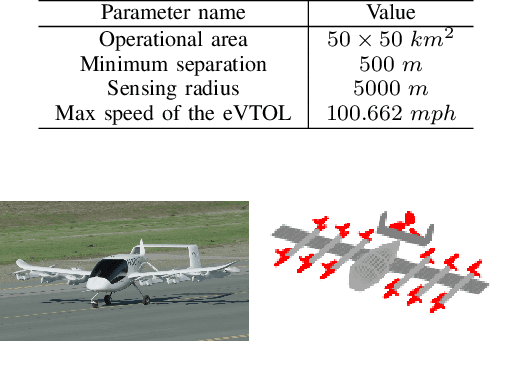

Abstract:In this paper, we developed a generalized simulation framework for the evaluation of electric vertical takeoff and landing vehicles (eVTOLs) in the context of Unmanned Aircraft Systems (UAS) Traffic Management (UTM) and under the concept of Urban Air Mobility (UAM). Unlike most existing studies, the proposed framework combines the utilization of UTM and eVTOLs to develop a realistic UAM testing platform. For this purpose, we first enhanced an existing UTM simulator to simulate the real-world UAM environment. Then, instead of using a simplified eVOTL model, a realistic eVTOL design tool, namely SUAVE, is employed and an dilation sub-module is introduced to bridge the gap between the UTM simulator and SUAVE eVTOL performance evaluation tool to elaborate the complete mission profile. Based on the developed simulation framework, experiments are conducted and the results are presented to analyze the performance of eVTOLs in the UAM environment.
A Clustering-based Framework for Classifying Data Streams
Jun 22, 2021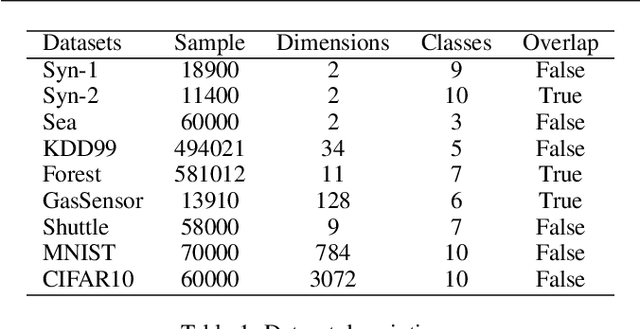


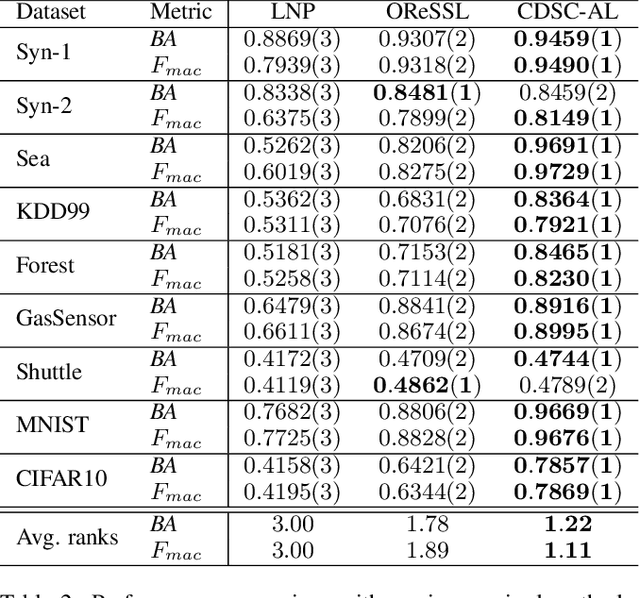
Abstract:The non-stationary nature of data streams strongly challenges traditional machine learning techniques. Although some solutions have been proposed to extend traditional machine learning techniques for handling data streams, these approaches either require an initial label set or rely on specialized design parameters. The overlap among classes and the labeling of data streams constitute other major challenges for classifying data streams. In this paper, we proposed a clustering-based data stream classification framework to handle non-stationary data streams without utilizing an initial label set. A density-based stream clustering procedure is used to capture novel concepts with a dynamic threshold and an effective active label querying strategy is introduced to continuously learn the new concepts from the data streams. The sub-cluster structure of each cluster is explored to handle the overlap among classes. Experimental results and quantitative comparison studies reveal that the proposed method provides statistically better or comparable performance than the existing methods.
Deep Learning with Attention Mechanism for Predicting Driver Intention at Intersection
Jun 10, 2020



Abstract:In this paper, a driver's intention prediction near a road intersection is proposed. Our approach uses a deep bidirectional Long Short-Term Memory (LSTM) with an attention mechanism model based on a hybrid-state system (HSS) framework. As intersection is considered to be as one of the major source of road accidents, predicting a driver's intention at an intersection is very crucial. Our method uses a sequence to sequence modeling with an attention mechanism to effectively exploit temporal information out of the time-series vehicular data including velocity and yaw-rate. The model then predicts ahead of time whether the target vehicle/driver will go straight, stop, or take right or left turn. The performance of the proposed approach is evaluated on a naturalistic driving dataset and results show that our method achieves high accuracy as well as outperforms other methods. The proposed solution is promising to be applied in advanced driver assistance systems (ADAS) and as part of active safety system of autonomous vehicles.
Driver Identification Based on Vehicle Telematics Data using LSTM-Recurrent Neural Network
Nov 19, 2019



Abstract:Despite advancements in vehicle security systems, over the last decade, auto-theft rates have increased, and cyber-security attacks on internet-connected and autonomous vehicles are becoming a new threat. In this paper, a deep learning model is proposed, which can identify drivers from their driving behaviors based on vehicle telematics data. The proposed Long-Short-Term-Memory (LSTM) model predicts the identity of the driver based on the individual's unique driving patterns learned from the vehicle telematics data. Given the telematics is time-series data, the problem is formulated as a time series prediction task to exploit the embedded sequential information. The performance of the proposed approach is evaluated on three naturalistic driving datasets, which gives high accuracy prediction results. The robustness of the model on noisy and anomalous data that is usually caused by sensor defects or environmental factors is also investigated. Results show that the proposed model prediction accuracy remains satisfactory and outperforms the other approaches despite the extent of anomalies and noise-induced in the data.
 Add to Chrome
Add to Chrome Add to Firefox
Add to Firefox Add to Edge
Add to Edge